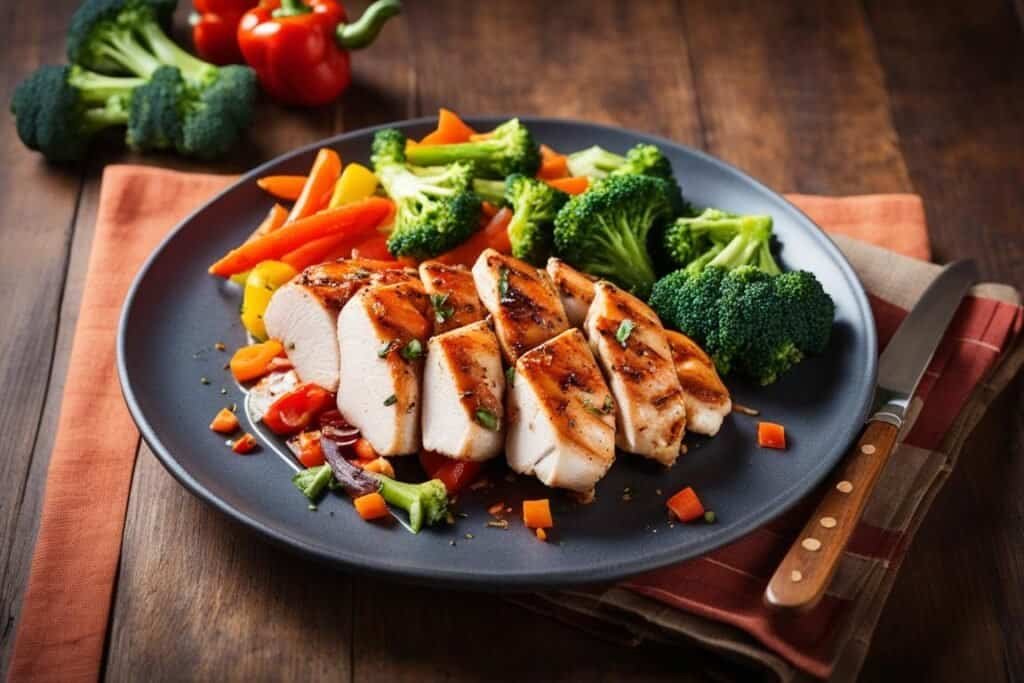
When it comes to balancing a nutritious diet with delicious choices, you might often consider the classic chicken breast. Recognized for its versatility and health benefits, chicken breast is a staple in many of your meals. But have you considered how much cholesterol in chicken breast there might be? Understanding the chicken breast cholesterol content is essential, especially when you’re being mindful of your heart health.
Indeed, chicken breast is lauded for being a lean meat option—with a reputation for typically lower fat content. This makes it a widely recommended choice by nutrition experts. Yet, navigating the maze of nutrition facts, you might pause to ponder the chicken breast cholesterol levels. While it’s true that the body requires a certain level of cholesterol for crucial functions such as hormone production and cell growth, too much can tip the scales towards health risks.
Factors like whether the skin is on, the cooking method, and even the chicken’s feeding practices can impact the cholesterol you consume with every tender bite. Is it possible to enjoy your chicken and maintain a healthy cholesterol level too? Stay with us as we dive into the chicken breast health facts that matter to you.
Understanding Cholesterol in Your Diet
When it comes to maintaining a balanced diet, being aware of the cholesterol in chicken breast per serving is crucial. Cholesterol isn’t all bad; your body uses it for vital functions like hormone production, vitamin synthesis, and digestion. Yet, too much cholesterol, especially the LDL type, can have adverse effects, leading to plaque buildup in your arteries and increasing the risk of cardiovascular diseases.
Did you know that chicken, a staple in many of our diets, contributes differently to our cholesterol levels depending on the part we consume? Among the various parts of chicken, the breast is notably lower in cholesterol. This makes it an excellent choice for those looking to enjoy meat without as much concern for their cholesterol intake. Let’s dive into chicken breast nutritional information and see how this lean meat fits into a heart-healthy diet.
To give you a clearer picture of what opting for skinless chicken breast can mean for your health, here’s a table that breaks down the cholesterol content:
| Chicken Part | Cholesterol per Serving | Notes |
|---|---|---|
| Breast, skinless | 63 mg | Lower in fat, high in protein |
| Leg, skinless | 81 mg | Higher in fat than breast |
| Wing, with skin | 85 mg | Skin adds additional cholesterol |
Choosing skinless chicken breast can be a lean option that’s lower in cholesterol. Remember, factors such as heredity, race, and body weight also play a part in influencing cholesterol levels, so make sure to consider these aspects along with dietary choices. Opting for skinless poultry, cooking it in a healthy way like grilling or baking, and watching your portions are simple yet effective steps you can take to manage cholesterol intake effectively.
How Much Cholesterol in Chicken Breast
When you’re watching your cholesterol levels, understanding the chicken breast cholesterol amount is crucial. The good news is that chicken breast is one of the leanest parts of the bird and offers less cholesterol content compared to other parts. Specifically, a 100 gram serving of chicken breast without skin has approximately 73 milligrams of cholesterol, making it a preferable choice for heart-healthy diets.
| Chicken Part | Cholesterol Content (per 100g) |
|---|---|
| Chicken Breast without Skin | 73 mg |
| Chicken Thigh without Skin | 94 mg |
| Chicken Wings without Skin | 111 mg |
If you’re interested in how much cholesterol in chicken breast can impact your diet, it’s worth noting that the skin of the chicken significantly contributes to the fat and cholesterol content. By opting for skinless cuts, you’re already taking a step towards a healthier lifestyle. Keep in mind that moderation is key, even with healthier options like chicken breast.
Chicken Breast Nutritional Information
If you’re searching for lean protein sources, chicken breast nutritional information might surprise you with its health benefits. With approximately 22.5 grams of protein per 100 grams, chicken breast serves as a powerful muscle-building food. Moreover, a modest fat content of 2.62 grams per serving reinforces its place as a go-to choice for those monitoring their dietary fat intake. But what about cholesterol?
Concerns such as “is chicken breast high in cholesterol?” often arise when considering a balanced diet. It’s reassuring to know that chicken breast offers a moderate amount of cholesterol, only 73 mg per 100 grams. Staying within the recommended limit of 300 mg of cholesterol per day, you can comfortably enjoy chicken breast without overloading on cholesterol.
Organic chicken, often preferred for its purported lower fat and cholesterol levels, might also contribute to healthier portion sizes due to its typically smaller build. Here’s a concise breakdown of the nutritional value found in a 100-gram serving of chicken breast:
| Nutrient | Amount |
|---|---|
| Protein | 22.5g |
| Total Fat | 2.62g |
| Cholesterol | 73mg |
Keep in mind, the way you cook your chicken breast can influence its nutritional value. Cooking methods that require little to no additional fat, such as grilling or poaching, are excellent choices to maintain the lean quality of the chicken.
By incorporating skinless chicken breast into your diet, you tap into a valuable source of essential nutrients while managing your cholesterol levels. And when it comes to making informed choices about your health, knowing the chicken breast nutritional information is an empowering step forward.
Is Chicken Breast High in Cholesterol?
When it comes to your diet, you might wonder, “is chicken breast high in cholesterol?” Rest assured, chicken breast is considered a healthier option, particularly for those monitoring their cholesterol intake. The amount of cholesterol in chicken breast is relatively low, especially when you compare it to other popular meat cuts.
Chicken breast cholesterol levels stand out for being lower than those found in other parts of the bird, such as the thigh or wing. In fact, when skinless, it boasts significantly less cholesterol, making it a standout choice for a heart-healthy diet.

| Chicken Cut | Cholesterol (mg per 100g) |
|---|---|
| Breast (skinless) | 73 |
| Thigh (skinless) | 94 |
| Wing (with skin) | 111 |
| Liver | 564 |
Add to that, the way you cook chicken breast can influence its cholesterol content. Methods that don’t involve added fats—such as grilling or baking—are preferred. These practices help to maintain the inherent lower cholesterol levels, which aligns perfectly with a cholesterol-conscious lifestyle.
So, to answer your question, a skinless chicken breast is low in cholesterol and, with mindful cooking, can be an excellent addition to your diet.
Strategies to Lower Cholesterol Intake from Chicken
When it comes to your health, understanding the cholesterol content in chicken breast and implementing strategies to lower cholesterol intake is crucial. The good news is that with a few smart choices, you can enjoy this lean protein while keeping your heart health in check. Let’s explore how you can minimize the cholesterol you consume from chicken.
First and foremost, opting for skinless chicken breast is a step in the right direction. The skin of the chicken adds significant amounts of cholesterol and fat, which you’re trying to avoid. But it doesn’t stop there; how you cook your chicken breast also matters. Baking or grilling instead of frying can dramatically reduce the amount of cholesterol in your meal. Here’s a handy comparison of cooking methods to guide you:
| Cooking Method | Cholesterol Content | Fat Content |
|---|---|---|
| Baked Chicken Breast | 73 mg per 100g | 3.5 g per 100g |
| Grilled Chicken Breast | 73 mg per 100g | 4.0 g per 100g |
| Fried Chicken Breast (with skin) | 89 mg per 100g | 8.8 g per 100g |
Beyond selecting the right cut and cooking method, overall dietary patterns play a crucial role in managing cholesterol. Integrating a delightful variety of fruits, vegetables, and whole grains into your meals, along with lean proteins like chicken breast, can significantly lower LDL cholesterol. Couple this with lifestyle choices such as engaging in regular physical activity and stress management, and you’re on your way to a healthier heart.
Don’t overlook the potential for technology to assist in your wellness journey. Apps can offer tailored nutrition advice and help track your health and cholesterol levels, bringing personalized guidance right to your fingertips.
Investing in these dietary and lifestyle changes will not only assist in managing cholesterol intake but also reinforce chicken breast health facts as part of a balanced nutrition plan. Remember, managing cholesterol isn’t just about avoiding certain foods; it’s about creating a varied and enjoyable dietary pattern that supports your long-term health.
Conclusion
Understanding the chicken breast cholesterol content may indeed influence your dietary choices, given its role in maintaining heart health. While chicken breast certainly contains cholesterol, the levels can be relatively low, particularly when you opt for a skinless variety and use healthful cooking methods. Remember, how much cholesterol in chicken breast per serving ends up on your plate is also a matter of portion control and the cooking technique you choose. Grilled or baked chicken breast can be a lean addition to your meals without the excess cholesterol that comes with frying.
Further integrating chicken breast health facts into your lifestyle includes maintaining balance with other nutritious foods. A colorful array of vegetables, whole grains, and fruit can complement the benefits of chicken breast, creating an overall diet that supports not just heart health but also whole-body wellness. By managing your diet with smart choices, you are taking significant steps towards a life with well-regulated cholesterol levels.
In sum, if you’re watchful of the details — portion sizes, skin presence, and preparation methods — enjoying chicken breast can be part of a health-conscious regimen. With a diet that includes moderate amounts of chicken breast and a mix of other nutrient-rich foods, you can savor the benefits of this versatile protein. Ultimately, it’s about making informed choices that align with a heart-friendly nutritional path and your personal wellness goals.
Key Takeaways
- Chicken breast is known for lower cholesterol levels compared to other cuts.
- Removing the skin can significantly reduce the cholesterol content in chicken breast.
- Cholesterol is essential for the body, but its excess can lead to health risks.
- The cooking method can affect the cholesterol content in your meal.
- A balanced diet, including lean meats like chicken breast, is key for cholesterol management.
- Regular exercise and a comprehensive lifestyle approach are vital for heart health.
